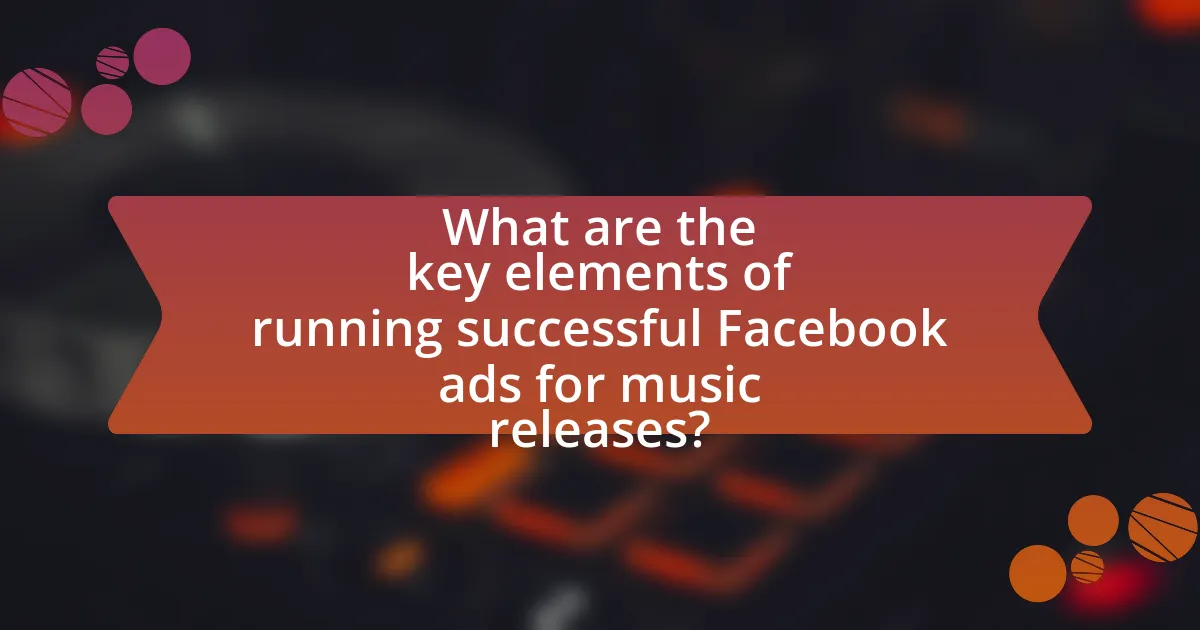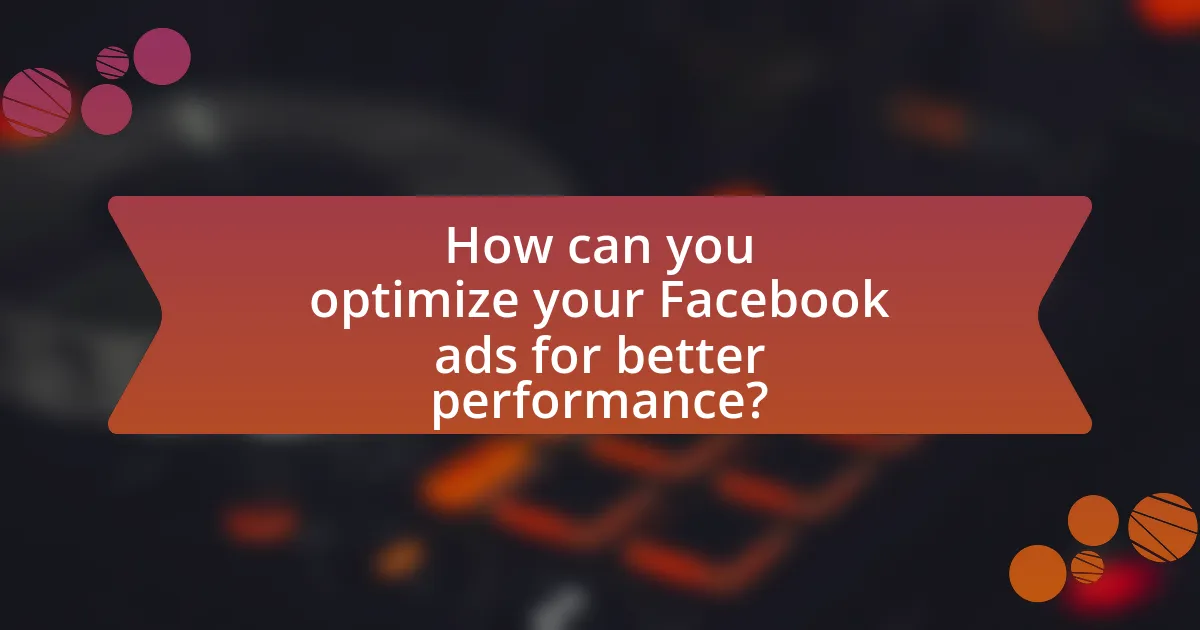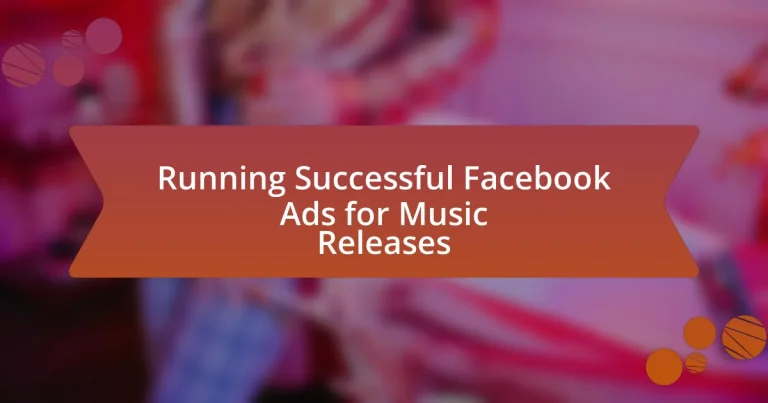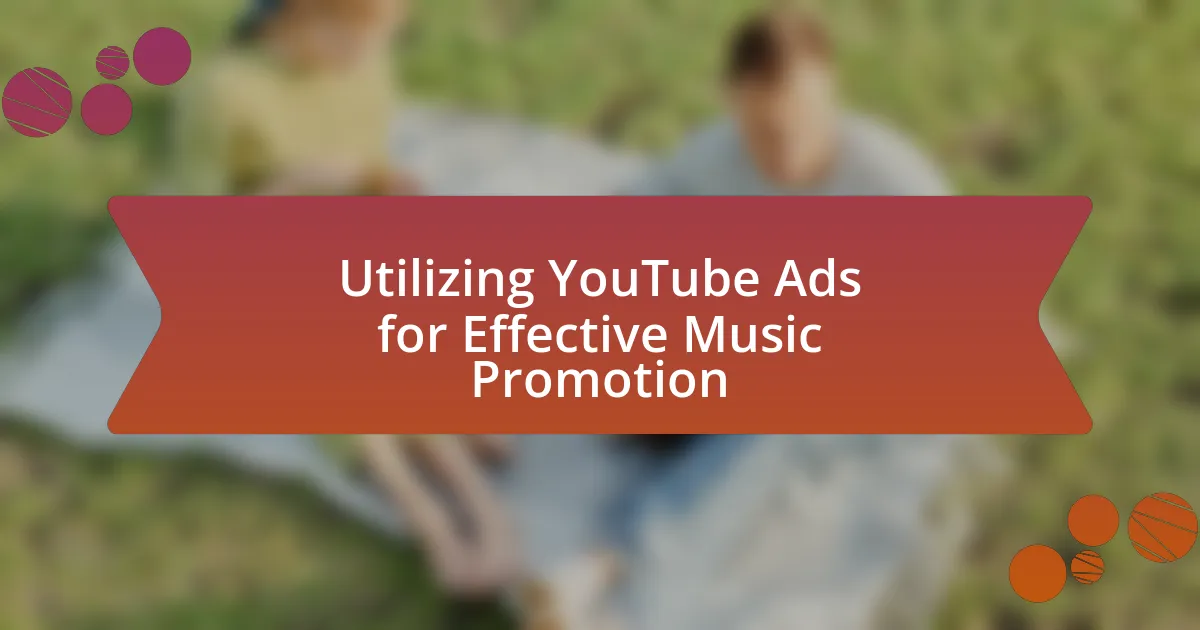The article focuses on the essential strategies for running successful Facebook ads specifically for music releases. It outlines key elements such as audience targeting, engaging ad content, effective visuals, and performance optimization through analytics. The discussion includes methods for defining target audiences, utilizing Facebook’s Audience Insights, and selecting effective ad formats like video and carousel ads. Additionally, it emphasizes the importance of ad copy, visuals, and metrics for measuring success, while also addressing budget considerations and best practices for enhancing engagement and conversion rates.

What are the key elements of running successful Facebook ads for music releases?
The key elements of running successful Facebook ads for music releases include targeting the right audience, creating engaging ad content, utilizing effective visuals, and optimizing ad performance through analytics. Targeting the right audience ensures that the ads reach listeners who are likely to engage with the music, which can be achieved through demographic and interest-based targeting options available on Facebook. Engaging ad content, such as compelling copy and a clear call-to-action, captures attention and encourages interaction. Effective visuals, including high-quality images or videos of the music release, enhance the ad’s appeal and can significantly increase click-through rates. Finally, optimizing ad performance through analytics allows for adjustments based on real-time data, ensuring that the campaign remains effective and reaches its goals. According to Facebook’s own advertising guidelines, ads that are well-targeted and visually appealing can lead to higher engagement rates, making these elements crucial for success.
How do you define your target audience for music ads?
To define the target audience for music ads, analyze demographic data, psychographics, and behavioral patterns of potential listeners. This involves identifying age, gender, location, and interests that align with the music genre being promoted. For instance, if targeting a young audience for pop music, data from platforms like Spotify and Facebook Insights can reveal that listeners aged 18-24 are the most engaged. Additionally, understanding listener behaviors, such as streaming habits and social media interactions, helps refine the audience further. This targeted approach increases ad effectiveness by ensuring that the content resonates with the specific preferences and habits of the audience.
What demographics should you consider when targeting music listeners?
When targeting music listeners, consider demographics such as age, gender, location, and interests. Age is crucial as different age groups have distinct music preferences; for example, younger audiences may gravitate towards pop and hip-hop, while older listeners might prefer classic rock or jazz. Gender influences music taste as well, with studies showing that men and women often have different genre preferences. Location matters because regional trends can affect music popularity; for instance, country music is more popular in rural areas compared to urban settings. Lastly, interests, including lifestyle and cultural affiliations, can help refine targeting, as individuals with specific hobbies or cultural backgrounds may be more inclined to engage with certain music genres.
How can you use Facebook’s audience insights to refine your targeting?
You can use Facebook’s Audience Insights to refine your targeting by analyzing demographic data, interests, and behaviors of your current audience and potential customers. This tool provides detailed information about age, gender, location, and interests, allowing you to create more tailored ad campaigns. For instance, if you discover that a significant portion of your audience is aged 18-24 and interested in specific music genres, you can adjust your targeting parameters to focus on this demographic, increasing the likelihood of engagement and conversions. Additionally, Audience Insights allows you to compare your audience with the general Facebook population, helping you identify unique characteristics that can inform your advertising strategy.
What types of ad formats are most effective for music releases?
Video ads are the most effective ad format for music releases. They engage audiences visually and audibly, allowing artists to showcase their music and personality. According to a study by Facebook, video ads can increase engagement rates by up to 6 times compared to static images. Additionally, carousel ads, which allow multiple images or videos to be displayed, are also effective as they enable artists to tell a story or highlight different aspects of their music. These formats leverage the platform’s algorithm, which favors engaging content, thus maximizing reach and impact for music releases.
What are the advantages of using video ads for music promotion?
Video ads for music promotion offer enhanced engagement, as they combine visual and auditory elements that capture audience attention more effectively than static ads. This multimedia approach allows artists to showcase their music, personality, and brand in a dynamic way, leading to higher viewer retention rates. According to a study by Wyzowl, 84% of consumers reported being convinced to buy a product after watching a brand’s video. Additionally, video ads can be easily shared across social media platforms, increasing organic reach and potential virality. This sharing capability is crucial in the music industry, where word-of-mouth and social proof play significant roles in audience growth.
How do carousel ads enhance engagement for music releases?
Carousel ads enhance engagement for music releases by allowing artists to showcase multiple tracks or visuals in a single ad unit, which captures user attention more effectively than static ads. This format encourages interaction as users can swipe through different images or videos, leading to increased time spent on the ad and a higher likelihood of clicks. According to Facebook’s internal data, carousel ads can lead to a 10-20% increase in engagement compared to single image ads, making them a powerful tool for promoting new music.
What is the importance of ad copy and visuals in music ads?
Ad copy and visuals are crucial in music ads as they significantly influence audience engagement and conversion rates. Effective ad copy captures attention, conveys the essence of the music, and prompts action, while compelling visuals enhance emotional connection and brand identity. Research indicates that ads with strong visuals can increase engagement by up to 94%, demonstrating the power of visual elements in attracting potential listeners. Furthermore, well-crafted ad copy can lead to a 20% increase in click-through rates, underscoring its role in driving traffic to music platforms. Together, they create a cohesive message that resonates with the target audience, ultimately leading to successful music releases.
How can you craft compelling ad copy that resonates with music fans?
To craft compelling ad copy that resonates with music fans, focus on emotional connection and authenticity. Music fans are drawn to content that reflects their passions and experiences, so using relatable language and imagery that evokes feelings associated with music can enhance engagement. For instance, referencing specific genres, artists, or lyrics that resonate with the target audience can create a sense of belonging and relevance. Research shows that emotional storytelling in advertising can increase engagement rates by up to 23%, highlighting the importance of connecting on a personal level.
What role do visuals play in capturing attention for music ads?
Visuals play a crucial role in capturing attention for music ads by enhancing engagement and conveying the emotional essence of the music. Research indicates that ads featuring compelling visuals can increase viewer retention by up to 65%, as they create a stronger connection with the audience. Effective visuals, such as vibrant imagery or dynamic video clips, not only attract initial attention but also help communicate the artist’s brand and the mood of the music, making the ad more memorable. This is supported by studies showing that 90% of information transmitted to the brain is visual, highlighting the importance of visuals in advertising effectiveness.

How can you optimize your Facebook ads for better performance?
To optimize your Facebook ads for better performance, focus on targeting the right audience, utilizing engaging visuals, and testing different ad formats. Targeting the right audience ensures that your ads reach individuals who are most likely to engage with your music, which can be achieved through Facebook’s detailed audience segmentation tools. Engaging visuals, such as high-quality images or videos, capture attention and increase click-through rates, as studies show that posts with visuals receive 94% more views than those without. Testing different ad formats, including carousel ads and video ads, allows you to determine which resonates best with your audience, leading to improved engagement and conversion rates.
What metrics should you track to measure ad success?
To measure ad success for music releases on Facebook, track metrics such as click-through rate (CTR), conversion rate, return on ad spend (ROAS), engagement rate, and cost per acquisition (CPA). CTR indicates how effectively your ad attracts clicks, with a higher percentage suggesting better performance. Conversion rate measures the percentage of users who take a desired action after clicking the ad, reflecting the ad’s effectiveness in driving sales or sign-ups. ROAS quantifies the revenue generated for every dollar spent on advertising, providing insight into the financial return of your campaigns. Engagement rate assesses how users interact with your ad, including likes, shares, and comments, which can enhance organic reach. Lastly, CPA calculates the cost incurred to acquire a customer, helping to evaluate the efficiency of your ad spend. These metrics collectively provide a comprehensive view of ad performance and effectiveness in achieving marketing goals.
How do click-through rates impact your ad strategy?
Click-through rates (CTR) significantly influence ad strategy by indicating the effectiveness of ad content in engaging the target audience. A higher CTR suggests that the ad resonates well with viewers, prompting them to take action, which can lead to increased conversions and sales. For instance, Facebook Ads with a CTR above 2% are generally considered successful, as they demonstrate strong audience interest. Consequently, marketers can use CTR data to refine their ad targeting, adjust messaging, and optimize visuals to enhance engagement and improve overall campaign performance.
What is the significance of conversion rates in music ad campaigns?
Conversion rates in music ad campaigns are crucial as they measure the effectiveness of advertising efforts in turning potential listeners into actual fans or customers. High conversion rates indicate that the ad content resonates well with the target audience, leading to actions such as streaming, purchasing, or sharing music. For instance, a study by Wordstream found that the average conversion rate for Facebook ads across all industries is about 9.21%, which highlights the importance of optimizing ad strategies to achieve similar or higher rates in music campaigns. This optimization can lead to increased revenue and a stronger fan base, making conversion rates a key performance indicator in assessing the success of music advertising initiatives.
How can A/B testing improve your ad effectiveness?
A/B testing can improve ad effectiveness by allowing marketers to compare two versions of an ad to determine which performs better. This method provides data-driven insights into audience preferences, enabling the optimization of ad elements such as visuals, copy, and targeting strategies. For instance, a study by HubSpot found that A/B testing can increase conversion rates by up to 49%, demonstrating its potential to enhance ad performance significantly. By systematically analyzing the results, marketers can make informed decisions that lead to higher engagement and better return on investment for their campaigns.
What elements should you test in your Facebook ads for music releases?
You should test the ad copy, visuals, audience targeting, call-to-action (CTA), and ad placement in your Facebook ads for music releases. Testing different ad copy allows you to determine which messaging resonates best with your audience, while varying visuals can help identify the most engaging images or videos. Audience targeting is crucial, as it enables you to reach the most relevant listeners, and experimenting with different CTAs can significantly impact click-through rates. Additionally, testing various ad placements, such as in-feed ads versus stories, can reveal where your audience is most likely to engage. These elements are essential for optimizing ad performance and maximizing reach and engagement for music releases.
How often should you conduct A/B tests for optimal results?
You should conduct A/B tests continuously throughout your advertising campaigns for optimal results. Regular testing allows you to adapt to changing audience preferences and improve ad performance over time. According to a study by Optimizely, companies that frequently run A/B tests can increase conversion rates by up to 49%. This frequency ensures that you are consistently optimizing your ads based on real-time data and audience feedback, leading to more effective Facebook ads for music releases.
What budget considerations are essential for running Facebook ads?
Essential budget considerations for running Facebook ads include setting a clear overall budget, determining daily or lifetime spending limits, and allocating funds based on campaign objectives. A clear overall budget helps define the maximum amount to spend, while daily or lifetime limits control expenditure over specific time frames. Allocating funds based on campaign objectives, such as brand awareness or conversions, ensures that resources are directed effectively. According to Facebook’s advertising guidelines, advertisers should also consider the cost-per-click (CPC) and cost-per-impression (CPM) metrics to optimize spending and achieve desired results.
How do you determine the right budget for your music ad campaign?
To determine the right budget for your music ad campaign, first assess your overall marketing goals and the audience you aim to reach. Establish a clear objective, such as increasing streams or ticket sales, and allocate a budget that aligns with the expected return on investment (ROI). For instance, if your goal is to achieve 1,000 new streams and you estimate that each stream costs $0.50 to acquire, your budget should be at least $500. Additionally, consider industry benchmarks; research indicates that successful music ad campaigns typically allocate 10-20% of projected revenue to advertising. This data-driven approach ensures that your budget is both realistic and effective in achieving your campaign objectives.
What bidding strategies can maximize your ad spend efficiency?
To maximize ad spend efficiency, employing automated bidding strategies such as Target Cost Per Action (CPA) and Cost Per Click (CPC) is effective. Target CPA allows advertisers to set a desired cost for conversions, optimizing bids to achieve that goal, which can lead to better budget management and increased return on investment. According to Facebook’s advertising guidelines, using automated bidding can improve performance by adjusting bids in real-time based on the likelihood of conversion, thus ensuring that ad spend is allocated efficiently. Additionally, utilizing bid caps within these strategies can help maintain control over spending while still optimizing for performance.

What strategies can enhance engagement and conversion for music ads?
Utilizing targeted audience segmentation enhances engagement and conversion for music ads. By analyzing demographics, interests, and behaviors, advertisers can tailor their messaging to resonate with specific groups, leading to higher interaction rates. For instance, Facebook’s advertising platform allows for precise targeting, which can increase ad relevance and effectiveness. According to a study by Facebook, ads that are relevant to the audience can see up to 50% higher engagement rates. Additionally, incorporating compelling visuals and audio snippets in ads can capture attention and encourage shares, further amplifying reach and conversion potential.
How can you leverage social proof in your ads?
You can leverage social proof in your ads by showcasing testimonials, user-generated content, and endorsements from influencers or industry experts. Incorporating real customer reviews and ratings can enhance credibility, as studies show that 79% of consumers trust online reviews as much as personal recommendations. Additionally, displaying the number of followers, likes, or shares can create a sense of popularity and trustworthiness, further encouraging potential customers to engage with your music releases.
What types of testimonials or reviews work best for music promotions?
Endorsements from well-known artists or influencers work best for music promotions. These testimonials leverage the credibility and reach of established figures in the music industry, significantly enhancing the perceived value of the music being promoted. For instance, a study by Nielsen Music found that 70% of music consumers are influenced by recommendations from artists they admire. Additionally, user-generated reviews that highlight personal experiences with the music, such as emotional connections or memorable moments, also resonate well with audiences, as they provide authenticity and relatability.
How can user-generated content boost your ad credibility?
User-generated content boosts ad credibility by providing authentic testimonials and relatable experiences from real users. This type of content enhances trust, as 79% of consumers say user-generated content highly impacts their purchasing decisions. When potential customers see genuine reviews, photos, or videos from other users, they perceive the brand as more trustworthy and reliable. Additionally, user-generated content often reflects diverse perspectives, making ads more relatable and appealing to a broader audience, which can lead to increased engagement and conversion rates.
What role does retargeting play in Facebook ad campaigns for music?
Retargeting plays a crucial role in Facebook ad campaigns for music by allowing advertisers to re-engage users who have previously interacted with their content. This strategy enhances conversion rates by targeting individuals who have shown interest, such as visiting a music page or engaging with a post, thereby increasing the likelihood of them taking further action, like streaming a song or purchasing tickets. According to a study by AdRoll, retargeting ads can lead to a 10x increase in click-through rates compared to standard display ads, demonstrating its effectiveness in capturing the attention of potential fans and driving engagement in the music industry.
How can you set up retargeting campaigns effectively?
To set up retargeting campaigns effectively, first, define your audience segments based on their interactions with your content, such as website visits, video views, or engagement with previous ads. Next, create tailored ad content that resonates with each segment, emphasizing the specific actions they took, like visiting a music release page or watching a music video. According to a study by AdRoll, retargeting ads can lead to a 10x increase in click-through rates compared to standard display ads, demonstrating the effectiveness of personalized messaging in retargeting efforts.
What audience segments should you focus on for retargeting music ads?
Focus on the following audience segments for retargeting music ads: previous listeners, website visitors, and social media engagers. Previous listeners are individuals who have streamed or purchased music from the artist, indicating a pre-existing interest. Website visitors include those who have interacted with the artist’s official site, showing intent to learn more. Social media engagers are users who have liked, shared, or commented on the artist’s posts, reflecting active engagement. These segments are effective because they have already demonstrated interest in the artist’s music, increasing the likelihood of conversion in retargeting campaigns.
What are some best practices for creating engaging music ads?
To create engaging music ads, focus on high-quality visuals and compelling audio that resonate with your target audience. Research shows that ads featuring vibrant imagery and catchy hooks capture attention more effectively, leading to higher engagement rates. For instance, a study by Facebook found that ads with strong visual elements can increase viewer retention by up to 65%. Additionally, incorporating storytelling elements in your ads can create an emotional connection, making the content more relatable and memorable. Using targeted audience insights to tailor your messaging further enhances relevance, as personalized ads can improve click-through rates by 50%.
How can storytelling enhance the impact of your music ads?
Storytelling can enhance the impact of music ads by creating an emotional connection with the audience, which increases engagement and memorability. When music ads incorporate narratives, they allow listeners to relate to the content on a personal level, making the music more appealing. Research shows that ads with storytelling elements can increase viewer retention by up to 22 times compared to those without narratives. This is because stories evoke emotions, which are crucial for memory retention and decision-making. Therefore, integrating storytelling into music ads not only captures attention but also fosters a deeper connection, ultimately driving listener action and loyalty.
What common mistakes should you avoid when running Facebook ads for music releases?
Common mistakes to avoid when running Facebook ads for music releases include targeting the wrong audience, neglecting ad creatives, and failing to track performance metrics. Targeting the wrong audience can lead to low engagement and wasted budget, as ads may not reach potential fans who are genuinely interested in the music genre. Neglecting ad creatives, such as using low-quality images or unclear messaging, can result in poor click-through rates and diminished interest in the release. Additionally, failing to track performance metrics means missing out on valuable insights that can inform future campaigns, leading to repeated mistakes and ineffective spending. According to Facebook’s advertising guidelines, effective targeting and engaging creatives are crucial for maximizing ad performance.




